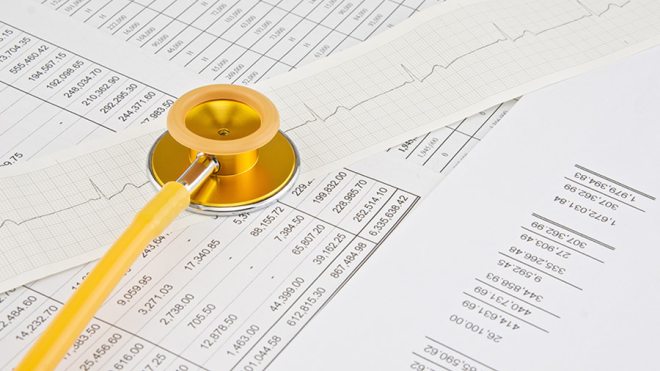
Markets remain very unsettled and not-for-profit healthcare issuance remains relatively light. Modest available reinvestment funds paired with the potential for very material single-day and single-week swings across all capital markets continue to create challenges across financing and investments.
|
1 Year |
5 Year |
10 Year |
30 Year |
|
|
July 8 – Treasury |
2.95% |
3.14% |
3.10% |
3.27% |
|
v. June 24 |
+12 bps |
-4 bps |
-2 bps |
+2 bps |
|
July 8 – MMD* |
1.47% |
2.05% |
2.49% |
3.01% |
|
v. June 24 |
-16 bps |
-21 bps |
-30 bps |
-24 bps |
|
July 8 – MMD/UST |
49.83% |
65.29% |
80.32% |
92.05% |
|
v. June 24 |
-7.77% |
-5.78% |
-9.10% |
-7.95% |
|
*Note: MMD assumes 5.00% coupon |
||||
SIFMA reset this week at 0.78%, which is approximately 41.66% of 1-Month LIBOR and represents a -20 basis point adjustment versus the June 22 reset.
Cognitive Illusion and Unanchored Expectations
The 2022 Kaufman Hall Healthcare Leadership Conference, with both in-person and virtual options, is set for October 20 – 21 at the Four Seasons. Chicago in October is great, the Four Seasons is great, and the conference line-up is great. Details and registration links are here, and we very much hope you can join us in person or virtually (the early bird rate ends Friday, July 15!).
One of my favorite conference moments was in 2017 when University of Chicago Professor Richard Thaler interviewed author Michael Lewis about his then recently released book titled The Undoing Project, which chronicles the incredible working friendship between the behavioral economists Amos Tversky and Daniel Kahneman. It is difficult to summarize these two, but one compelling thread was their idea of “cognitive illusion,” which simplistically is how human error can upend statistical or logical expectations. We might think of ourselves as data-driven analytical thinkers, but Tversky and Kahneman offered a more nuanced view grounded in the recognition that we drag all sorts of human baggage into our decision-making processes.
The Federal Reserve is wrestling with its own version of how cognitive illusion might impact their efforts to manage the arc of inflation. The terminology being thrown around is whether we (all of us participants in the economy) remain “anchored” to the Fed’s long-term target of a ~2% inflation rate or are we becoming so “unanchored” from that expectation that we will start undertaking individual transactions that will wind up sustaining or worsening inflationary pressures. The classic example is referred to as the wage-price spiral wherein the prospect of increasing prices leads to demands for increasing wages, which creates enough sustained demand to support additional price increases. It describes a self-perpetuating inflationary cycle fueled by expectations. The chart on inflation expectations measured in the most recent University of Michigan consumer survey, which was published in this July 5thWall Street Journal article, demonstrates a major realignment between December 2019 and today. Seems we might already be unanchored.

The first problem with our collective drift—let’s call it a “cognitive illusion spiral”—is what it suggests for the distribution of possible outcomes; the more unanchored we become, the greater the pressure on the Fed to deprioritize recession concerns and move rates sharply higher. Right now, anyone charged with running a not-for-profit healthcare company confronts an incredibly wide range of possibilities, each of which offers different implications across their enterprise’s operating, financing, and investing activities. The second problem—let’s call it the “reality spiral”—is that taming the rate of inflation is analogous to closing the barn door after the horses have not only left the barn but have scattered all over the county. The Fed missed the mark in meeting its price stability mandate; within the healthcare sub-economy, this has contributed to a major reset in the revenue-expense relationship that will not get fixed by realigning consumer expectations to a 2% inflation target. Pressure will escalate, and any fix is going to lie in restructuring the business model, which will require coordinated work across operating, financing, and investing activities.
Other Things to Track
The Fed recently completed its annual bank stress test, which is a Dodd-Frank creation designed to assess whether banks have sufficient capital to survive various adverse market environments. This year’s test was more difficult than prior years and included the assumption of a severe global recession with major pressures in the real estate and corporate debt markets. All banks passed but not all performed as well as expected. It will be important to pay close attention to whether these results have any incremental impact—beyond the Fed’s broader tightening efforts—on the cost or availability of bank credit-liquidity.
Moody’s has started rolling out formal ESG “scores” across its healthcare client base. They are publishing component scores ranging from 1 to 5 for each Environmental, Social, and Governance category as well as a comprehensive score, also on a 1-to-5 scale (1 is the best score and 5 is the worst). Moody’s points out that ESG is already embedded in their rating analysis, and they suggest that no rating will be adjusted because of a newly released ESG score. That may be true, but the concern is what investors are going to do with this information and whether certain score thresholds will impact their willingness or ability to purchase obligations of certain issuers. Will an ESG-driven investor prioritize the ESG score over the credit rating? It’s too soon to know. Either way, this is a useful reminder that investors are a rating agency’s primary customer base. Moody’s indicated that they are in the process of contacting their rated healthcare issuers, so expect a call. Also note that Lisa Goldstein and others on our team have done a lot of great thought leadership on this important topic; there is an ESG page on the Kaufman Hall website which you can access here.
Trending in Healthcare Treasury and Capital Markets is a biweekly blog providing updates on changes in the capital markets and insights on the implications of industry trends for Treasury operations, authored by Kaufman Hall Managing Director Eric Jordahl.





